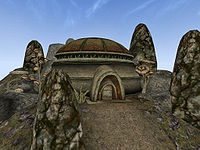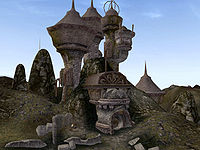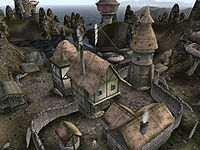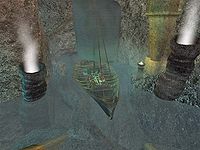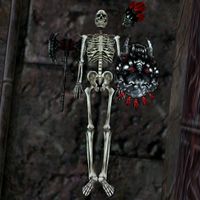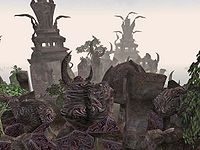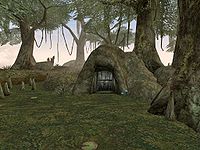User:Vincentius1/Sandbox
Disclaimer: If you come across this sandbox and have a suggestion for an edit, feel free to add or fix whatever you want. It's all good, my guy. This is gonna be a mass expansion for Vvardenfell's history section.
Contents
Early History[edit]
Vvardenfell and its coasts were originally discovered in the middle Merethic Era by Aldmeri explorers. They built First Era-style Altmer wizard towers primarily on Azura's Coast, but the four specifically were Ald Redaynia, Bal Fell, Tel Aruhn, and Tel Mora.[1] The Dwemer of Morrowind, who would later populate the island came from these early Aldmer.[2] and even coined the island's name; Vvardenfell, which translates to "City of the Strong Shield".[3] The Chimer eventually followed Veloth the Pilgrim to ancient Morrowind and they inhabited every corner of the region, including Vvardenfell.[1]
High Velothi Culture was on the rise as the Chimer; ambitious, well-established clans and devout worshippers of the Daedra came into conflict with the Dwemer, who they detested for their secular culture and practices but sought their land. Their constant back and forward went on for years and as the Dwemer reclused themselves in the Velothi Mountains,[1][2] the Chimer lived as nomads collectively known as the Velothi and wandered the wastes for days on end.[1][4]
They would amass an abundance of knowledge over time and safeguard it in the Library of Andule, a sanctuary whose very location was kept secret by prominent clans that eventually became the thirty ancient families of Vvardenfell.[5][6] One of the oldest families on the island is the Veloth clan, who claim to be descendants of Veloth. Since then, the family has had a long and prominent history on the island.[7]
At some point during this time, Vvardenfell was terrorized by the Emperor Crab known as Skar. Four nomads banded their people together to fight this common threat. These four leaders were the First Ashkhans, founders of the modern four tribes of Vvardenfell.[8] The final battle took place between the west side of Red Mountain and the Foyada Drura. It was Dranoth Hleran who took down the monster and with his spear, Calderas. The Velothi settled along the fire river, where they benefitted from the wealth provided by Skar's carcass. These peaceful times ended when the next generation of Ashkhans took over and slaughtered Dranoth's kin, forcing them out of the waste for many years.[4]
The Decline of High Velothi Culture[edit]
Since then, Skar served as the foundation for a neutral meeting ground they called Ald'ruhn and Dranoth's legacy was tarnished as he was henceforth known as "the Unsung" by modern-day Ashlanders.[9] The tribesfolk have held Ald'ruhn in the utmost importance and continue to pass down the oral tradition of Skar's downfall. It has since become widely known across Dunmeri folklore.[8][10]
Meanwhile, Dranoth's descendants have long left the wastes and become the modern-day House Hleran,[4] a sub-faction of House Redoran.[8] The Great House accredits themselves as the ones to slay the Emperor Crabs that once dominated Vvardenfell.[11][12]
The Velothi settling around Skar is one of many examples of a gradual change in Resdayn as the late Merethic Era marked the decline of Velothi culture. Nomads settled around the old towers and built villages such as Gnisis around them. Tribal culture soon took over between them and either evolved into the modern-day Great Houses or the aforementioned Ashlander tribes that continue its tradition.[1]
One of the original Great Houses, Clan Dagoth built their capital, Kogoruhn on the southern slopes of Red Mountain.[13] The Ashland tribes on Vvardenfell; the Ahemmusa, Erabenimsun, Urshilaku, and the Zainab are the ones to keep the nomadic culture alive,[14] though other scholarly sources suggest they lived in old Chimer strongholds before living in camps.[15] While the Dwemer at the time began to build freehold colonies like Nchuleft,[1][16] both the settled and nomadic Chimer were considered equals by the early First Era.[17]
Some notable figures were present at this time, such as Divayth Fyr who spent his youth in Tel Aruhn[18] and Mavos Siloreth, who joined his mage-companions from Vvardenfell to seal the Brothers of Strife in Stonefalls.[19][20]
Vvardenfell in the Conquest of Morrowind[edit]
While the rest of Resdayn was enraptured in the Conquest of Morrowind, the Kingdom of Vvardenfell was never captured by the Nordic Empire as the Dwemer were well secured in their underground cities and freehold colonies. They united together to defend themselves against a common enemy, unlike the Chimer, whose ancient feuds were used to the Nords' benefit.[3]
That being said though, the war had reached Vvardenfell on a couple of occasions. During the greater Skyrim Conquests, Harald's sons dominated the northern coasts of Tamriel.[21] and one of their only known strongholds was Dagon Fel, which was built on the largest island in the Sheogorad archipelago.[22] Olmgerd the Outlaw, Harald's bastard son fought in the Conquest of Morrowind and was later buried on Vvardenfell, in a hidden cavern underneath the Marvani Ancestral Tomb.[21]
When the War of Succession broke out in the west and pitted the Nords against each other,[3] heroes of both the Chimer and Dwemer, Nerevar and Dumac
the Chimer saw the opportunity to fight back and gathered amongst each other to retaliate.[3] At the helm of this movement was Nerevar, a warrior recognized by the Chimer as the Hortator
The First Council[edit]
Sometime in the early First Era, around Wulfharth and his dynasty's reign over Skyrim, the noble, Mordrin Hanin had passed away and a wake took place in Ashurnabitashpi, a large fortress on Vvardenfell's north coast. Many notable people were invited, including representatives of Ald Sotha, Ashalmawia, and Maelkashishi, as well as the duo from Anudnabia; Hilbongard Rolamus and Dorach Gusal. The guests consumed an elixir made from Hanin's formula and many died from the poisoning, as per Hanin's plan to take people with him.[24]
Not long after that, Ald Sotha, the residence of House Sotha was destroyed by Mehrunes Dagon, the Daedric Prince of Destruction and his horde,[25] chief among them included Arox the Mutilator.[26] There is little speculation as to why it happened but while House Sotha was destroyed, it lived on through the young Sotha Sil saved by Vivec.[25]
Vvardenfell post-Conquest ([23], [24], [25])
Vvardenfell pre-Red Mountain and Tribunal myth (Sermons 1, 2, 4, 6. 37[27], [28]
Inner Sea creation (Sermon 36, [29])
The Battle of Red Mountain[edit]
Tribunal myth and other stories perpetuate the creation of the Inner Sea at this point in time, which was mainly caused by Red Mountain's eruption.[29] Vivec's 36th sermon goes on further by stating it was Numidium's activation at Kagrenac's hands that burnt through the Tribunal's armies and shattered the landscape to create the body of water.[30] Settlements such as Kemel-Ze on the modern-day Telvanni Peninsula were affected by the destruction.[29]
Vvardenfell after the Tribunal's ascension[edit]
Vvardenfell post-Red Mountain and Tribunal myth (12, 24, 25, 28, 31, 33, 34, 36)[27][31][28]
In 1E 2920, Prince Juilek and Vivec signed the Cervant Truce, which formally ended the Four-Score War. One of the agreements to the truce was that the Second Empire would facilitate key border castles across Morrowind in case of an overseas invasion. One such place was Tel Aruhn on Azura's Coast.[33]
Vvardenfell in the Second Era[edit]
Vivec City construction ([35])
In the late Second Era, Morrowind was invaded by Tiber Septim and the Imperial Army as part of the greater Tiber Wars. Overtime, the fight against the Cyrodiils became disorganized. It was not until Vivec appeared before the masses in his city and declared that a peace treaty would be created was when the situation changed. While the circumstances of the peace talk are unknown, one rumor suggested that Vivec leased Numidium to Tiber Septim to help in his conquest with the Aldmeri Dominion in return for preserving classical Dunmeri traditions in the transition of government.[36]
Vvardenfell and the Third Empire[edit]
As per the terms of the Armistice, Vvardenfell was made a Temple preserve under the protection of the Empire, and no one outside its borders could step forth on it.[37] From then on, the island district was administrated by the Duke of Vvardenfell, with one of the earliest known monarchs being Duchess Katariah Ra'athim of Ebonheart, whose family infamously served Queen Potema Septim in the War of the Red Diamond at the time. She left her position as the Duchess of Vvardenfell after she married King Pelagius Septim III, heir apparent to the Empire in 3E 145.[38][39]
Even though the island was barred from the outside, some people have entered it since then. In 3E 150, the daedric-worshipper of unknown origins, Dagoth Thras declared himself an heir to the Sixth House and resided in the ruins of Abernanit. The thrice-blessed Commander Rangidil Ketil led a force of Ordinators and Buoyant Armigers in an assault of the castle, despite their outnumbered forces.[40] Vivec City at the very least was open to the outside. Smugglers in the early-mid Third Era had active skooma routes between the city and Daggerfall all the way west.[41]
During the Imperial Simulacrum in the late Third Era, Vvardenfell contained three known settlements; Markgran Forest, Old Run, and Stoneforest.[42] After he banished Emperor Uriel Septim VII, the battlemage, Jagar Tharn broke the Staff of Chaos into seven pieces and placed one of them in Dagoth-Ur, the dwarven mines underneath Red Mountain. Sometime later, the Eternal Champion retrieved the Hammer of Gharen for the King of Ebonheart, who then struck it on the Anvil of Mithas and revealed the mines' location. The Champion then traveled to the island and acquired their last piece to assemble the staff.[43]
Since then, Imperial loyalists often go on pilgrimages across the Empire to re-trace the Champion's steps and make their way to Vvardenfell.[44] At around the same time, one of the last known Failed Incarnates, Peakstar was present on the island. She was found washed ashore near Ald Redaynia by the Urshilaku and over the course of years people believed she was special.[17][45] At some point in time, she survived the Blight but died while fighting an Ash Vampire. The Ordinators spent quite some time searching for her but to no avail, coming to the conclusion that she was dead.[46][47]
Imperial Administration and the Nerevarine Prophecy[edit]
The Red Year and onward[edit]
Known Rulers[edit]
Archcanon of the Canonry of Vvardenfell[edit]
|
Duke of Vvardenfell[edit]
|
References[edit]
- ^ a b c d e f Before the Ages of Man — Aicantar of Shimerene
- ^ a b Pocket Guide to the Empire, 3rd Edition: The Temple: Morrowind — Imperial Geographical Society, 3E 432
- ^ a b c d Pocket Guide to the Empire, 1st Edition: Morrowind — Imperial Geographical Society, 2E 864
- ^ a b c Dranoth Hleran's dialogue in ESO
- ^ The Library of Andule
- ^ Librarian Bradyn's dialogue in ESO
- ^ Veloth Ancestral Tomb loading screen text in ESO
- ^ a b c Drelyth Hleran's dialogue in ESO
- ^ Wise Woman Asani's dialogue in ESO
- ^ The Grave of Skar — Anrunn Frozen-Cove
- ^ Crafting Motif 52: Redoran Style — Vindamea Redoran, House Procurement Sister, Vivec City
- ^ Skar loading screen text in ESO
- ^ Sul-Matuul's dialogue in Morrowind
- ^ Ashlander Tribes and Customs — Ulran Releth of House Redoran
- ^ The Importance of Where — Marobar Sul
- ^ Chronicles of Nchuleft — An Anonymous Altmer
- ^ a b Notes from Huleeya — Huleeya
- ^ Sorcery is Not Necromancy! — Divayth Fyr
- ^ The Brothers of Strife — Nili Omavel
- ^ Onuja's dialogue in ESO
- ^ a b Ennbjof's Nord Burial quest in Morrowind
- ^ Dagon Fel generic description in Morrowind
- ^ a b The War of the First Council — Agrippa Fundilius
- ^ a b Hanin's Wake
- ^ a b c A Brief History of Ald Sotha — Varlinsi Arandu, Apostle of Sotha Sil
- ^ Arox the Mutilator's houseguest dialogue in ESO
- ^ a b The 36 Lessons of Vivec — Vivec
- ^ a b Tholer Saryoni's dialogue in Morrowind
- ^ a b c Ruins of Kemel-Ze — Rolard Nordssen
- ^ 36 Lessons of Vivec, Sermon 36 — Vivec
- ^ The House of Troubles
- ^ Imbel Genealogy
- ^ 2920, MidYear — Carlovac Townway
- ^ Breathing Water — Haliel Myrm
- ^ Foyada Quarry loading screen text in ESO
- ^ On Morrowind — Erramanwe of Sunhold
- ^ a b c A Short History of Morrowind — Jeanette Sitte
- ^ a b The Wolf Queen, v8 — Waughin Jarth
- ^ a b The Madness of Pelagius — Tsathenes
- ^ Death Blow of Abernanit — Anonymous (with notes by Geocrates Varnus)
- ^ Cap'n Dugal's Journal, Part 1 — Captain Torradan ap Dugal
- ^ Morrowind in Arena
- ^ Dagoth-Ur story quest in Arena
- ^ A Minor Maze
- ^ Ashlanders generic dialogue in Morrowind
- ^ Sharn gra-Muzgob's dialogue in Morrowind
- ^ Peakstar's dialogue in Morrowind
Note: The following references are considered to be unofficial sources. They are included to round off this article and may not be authoritative or conclusive.
